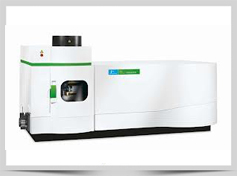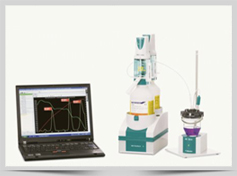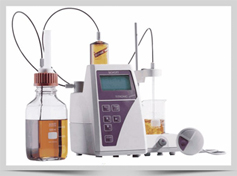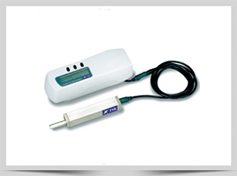Instrumentation
 INDUCTIVELY COUPLED PLASMA OPTICAL EMISSION SPECTROMETER (ICP-OES)
INDUCTIVELY COUPLED PLASMA OPTICAL EMISSION SPECTROMETER (ICP-OES)
Elemental analysis of metals in solution is performed using ICP-OES. In ICP-OES, an inductively coupled plasma is used to produce excited atoms and ions that emit light. The amount of light emitted is measured by the detector to give a quantitative metal determination. This technique has a low detection limit which makes it ideal for trace metal analysis.
THERMOMETRIC TITRATION SYSTEMS
Quantitative solution analysis can be performed by thermometric titration. This is a titration performed in an adiabatic system, yielding a plot of temperature versus volume of titrant. Theremometric titration can be used for neutralization, precipitation, redox, organic condensation, and complex-formation reactions. Using this technique, endpoints can be determined accurately and precisely without a subjective interpretation on the part of the analyst.
MICROHARDNESS TESTER
The Knoop and Vickers hardness of materials can be measured using a microhardness tester. This instrument is equipped with an indenter that penetrates the testing material at a specified force. The hardness of the material is determined by measuring the diagonal of the diamond-shaped indentation made by the indenter.
 MANUAL TITRATORS
MANUAL TITRATORS
Manual titrators are used to analyze solutions by volumetric methods. These are titration methods that involve a titrant and an indicator to signal the endpoint. The titrations may involve oxidation-reduction, acid-base, complexation, and precipitation reactions. The sample component can be determined based on the amount of titrant required to reach the endpoint.
X-RAY FLUORESCENCE SPECTROMETER
X-ray fluorescence is the industry standard for measurement of metal film coating thickness and composition, and substrate metal composition determination. Fluorescence is a process in which an atom or a molecule absorbs a photon of certain energy and releases another photon of lower energy. In X -ray fluorescence, the X-ray tube provides bombardment of excitation photons to the sample. Thickness or composition is determined by the intensity of the fluoresced X-rays.
 BETA BACKSCATTER COATING THICKNESS MEASUREMENT INSTRUMENT
BETA BACKSCATTER COATING THICKNESS MEASUREMENT INSTRUMENT
Non-destructive coating thickness measurements can be performed on this instrument using the Beta Backscatter method. Beta backscatter is a principle using beta rays and diverting them at a plated sample.
HULL CELL
The Hull Cell is among the most useful tools for control of plating electrolytes. It is a miniature plating unit designed to produce a cathode deposit that records the character of electroplate at all current densities within the operating range. Hull cells allow experienced operators to determine process parameters such as approximate bright range, presence of metallic and organic impurities, covering power, and throwing power.
 HANDYSURF E-35A SURFACE PROFILOMETER
HANDYSURF E-35A SURFACE PROFILOMETER
A contact profilometer is used to measure a surface's profile, in order to quantify its roughness. A diamond stylus is moved vertically in contact with a sample and then moved laterally across the sample for a specified distance and specified contact force. A profilometer can measure small surface variations in vertical stylus displacement as a function of position. The height position of the diamond stylus generates an analog signal which is converted into a digital signal stored, analyzed and displayed.